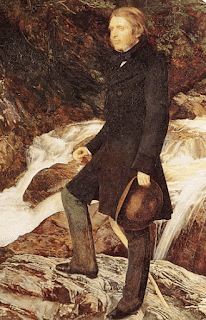Why John Ruskin might have welcomed the latest research
 |
| The Matterhorn from the moat of the Riffelhorn, by John Ruskin Image courtesy of the Ruskin Collection, Museum of Sheffield |
Seismometers hooked up near its summit, flank and foot showed that the Matterhorn oscillates in both a north-south and in an east-west direction, each at a frequency of 0.42 Hertz. The energy for these vibrations comes from earthquakes and tidal movements. They move the Matterhorn’s summit – albeit by microscopic amounts – more than they do its base.
For a more detailed account of the research, see the excellent write-up in the Daily Mail – always quick to spot a good celeb story – or, if you prefer a more scholarly rendition, the one published by Switzerland’s Institute for Snow and Avalanche Research. Don’t forget to listen to the sound recordings, amped up for human hearing.
 |
| Ruskin by Millais |
Be that as it may, the great critic had an intuitive sense of stone. Take his extraordinary riff on “slaty crystallines”, the gneiss-type rocks that for the most part make up the Matterhorn. In tracing their wavy structure to some "strange quivering of their substance", he seems almost to have anticipated the latest research:
We yield ourselves to the impression of their eternal, unconquerable stubbornness of strength; their mass seems the least yielding, least to be softened, or in anywise dealt with by external force, of all earthly substance.
And, behold, as we look farther into it, it is all touched and troubled, like waves by a summer breeze; rippled, far more delicately than seas or lakes are rippled: they only undulate along their surfaces—this rock trembles through its every fibre, like the chords of an Eolian harp—like the stillest air of spring with the echoes of a child’s voice. Into the heart of all those great mountains, through every tossing of their boundless crests, and deep beneath all their unfathomable defiles, flows that strange quivering of their substance. …
They .[the mountains] … are yet, also ordained to bear upon them the symbol of a perpetual Fear: the tremor which fades from the soft lake and gliding river is sealed, to all eternity, upon the rock; and while things that pass visibly from birth to death may sometimes forget their feebleness, the mountains are made to possess a perpetual memorial of their infancy,—that infancy which the prophet saw in his vision: “… I beheld the mountains, and lo, they trembled; and all the hills moved lightly.”
 |
| Fragment of the Alps, by John Ruskin Courtesy of the Havart Art Museum, Cambridge MA |
References
Samuel Weber, Jan Beutel, Mauro Häusler, Paul Geimer, Donat Fäh, Jeff Moore, “Spectral amplification of ground motion linked to resonance of large-scale mountain landforms”, Earth and Planetary Science Letters, 2021, doi: 10.1016/j.epsl.2021.117295
John Ruskin, Modern Painters, Vol IV, Chapter IX, “Of the materials of mountains: secondly, slaty crystallines"
No comments:
Post a Comment